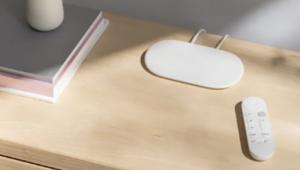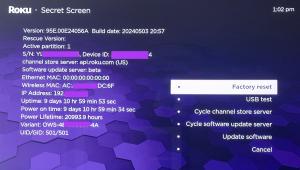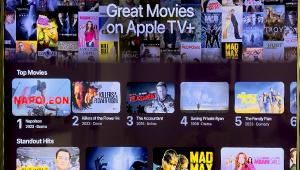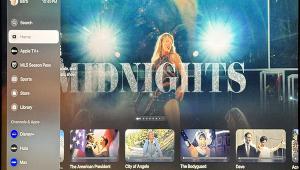Hands On: Roku Wireless Speakers and TCL Roku TV

I had the opportunity to test the Roku wireless speakers with a 5-Series TCL 4K HDR TV and was pleasantly surprised. Because the speakers are wireless, setup began by simply plugging into power and turning on the Roku TV. As each speaker powers up, it speaks to you, telling you what to do: “Hold down the home button on the Roku TV remote to start pairing. Press the Pair button to hear this message again.”
Ultimately, it was as simple to pair the speakers with the TV as the instructions described, but I experienced some confusion during testing of the pre-release samples. After pressing the Home button on the remote as instructed, there was no indication or displayed message that the pairing process had begun. When I went to the Settings menu on the Roku TV (Settings> Remotes and Devices> Pair Speakers), it showed that the speaker was indeed pairing and receiving a software update. Monitoring the progress, I saw that the speaker finally paired with the TV after the initial single long press of the Home button. When the first speaker was done, the second speaker automatically updated and paired with the TV. If Roku will create a message that lets the user know pairing has begun without the need to go into a menu, the company will have succeeded in designing the simplest way to add speakers to a TV.
Roku wireless speakers work only with Roku TVs, not with any of the Roku players. The TV must be running Roku OS 8.2 or above. (Roku OS 9 will come to Roku TVs in January 2019.) Within the new Roku TV operating system are settings for various sound modes that work with the speakers, including Automatic Volume Leveling, Speech Clarity, and Bass Boost. Automatic Volume Leveling reduces volume during loud action scenes (bombs exploding, gunfire, car chases) and boosts the volume during quieter scenes such as whispered dialog. There is also a Night mode that sets a maximum threshold for louder sounds, so the TV doesn’t disturb your sleeping family. While both of these sound modes are not new to TVs, in my testing it appears that the Roku TV and speakers have succeeded better than most others. Commercial volume levels did not rise when using Volume Leveling and the sound of explosions were suppressed in Night mode.
Users can access the sound mode setting by pressing the star (*) on the Roku TV remote when watching a video channel, then choosing Advanced Sound Settings. Here you can also change Speech Clarity from “Low” to “High.” It’s in the high speech-clarity mode that these speakers really shine. For the past year, I’ve been frustrated with certain TV shows in which the music and effects are loud, but I’ve had to turn up the volume to hear dialog. With the Roku wireless speaker set to “High” speech clarity, the dialog volume is boosted and enhanced — thus allowing me to understand what is being said even at low volume settings.
The exceptional voice reproduction performance of the speakers was also evident when I listened to music channels on the Roku TV. Whether I was tuned to Pandora, to the newly reintroduced Spotify, or when streaming from my phone to Roku TV’s new Bluetooth capabilities, the sound quality was surprisingly good. Music filled the room. Not only were the vocals clear; so were the highs and the lows. There was nothing tinny in the high range from the 3/4-inch tweeter, nor did the bass vibrate the 3.5-inch woofer. Overall, the Roku wireless speakers excelled in comparison to other bookshelf speakers in the same price range.

The speaker bundle includes two remote controls. The first is a remote that is nearly identical to the Roku TV remote. Because the speakers can’t be set up without a Roku TV and its remote, I’m not clear why that remote is needed. The second remote, a 3-inch square, is what Roku calls a Touch tabletop remote. Featuring a soft touch-top instead of individual buttons, this remote is intended to be placed in a second room from which you might also want to control the TV. The touch-top allows a user to press buttons with wet fingers so it can be used when working in the kitchen.
The Roku Touch is a voice remote that accepts voice commands. Two buttons can be programmed as presets for your most-used commands (i.e., Turn On/Off TV and Mute Sound). After saying a command, simply hold down one of the preset buttons to set it. Thereafter, a quick press of that preset button will send the command directly to the TV. The remote also has buttons for volume and playback; there are no navigation or selection buttons, because it is assumed that you won’t be looking at the TV when using the Roku Touch tabletop remote.
The Roku TV and speakers can also be controlled by a Google Assistant. In the past weeks I had issues when I tested voice commands from my Google Home (Google Assistant) to various Roku media players. In contrast, commands from the Google Home to the Roku TV and speakers worked perfectly. My Google Home was able to: power the TV on and off; launch channels (apps); adjust the volume up and down; mute the TV; and search for genres, actors, and titles.
During testing, I was not only pleasantly surprised with the sound quality of the Roku Wireless Speakers, but also with the quality of the 5-Series TCL Roku TV. The 49-inch flat-screen creates extremely deep blacks, and Dolby Vision HDR helps retain the details in the shadows. Because of the deep blacks, all colors are rich and clean. The picture far exceeded my expectations for a TV with a $400 price tag.
This Roku TV and wireless speaker set up will not replace a high-end home theater, but it’s a great choice for a second television. This will appeal to viewers who want a good quality system and want the simplicity of Roku. With excellent voice control, speech clarity and night sound modes, it offers fine value for the price. The Roku Wireless speakers with two remotes cost $200, but are being offered for $150 for Black Friday. They can be pre-ordered on roku.com. Shipping starts November 16th.
- Log in or register to post comments




























































